Since I became a parent, sleeping in on holidays and weekends has been a luxury of the past. Lacking sleep and energy, I am still required to sit and play with my child all day long, and frankly, it’s very tiring. Thankfully, I found ways to let my children play independently and get back my personal time.
Suppose you’re like me, who has to juggle my time and energy between playing with the kids and getting the house chores done; you understand that you will run out of energy to play or entertain your children. If your children can play independently, you will get to nap and have more time for yourself! Here’s how you can do it.
Setting Realistic Expectations for Independent Play
First, you have to have a realistic expectation of how long your child can play independently – all by himself, without needing or wanting you during that duration.
According to an article by Brain Balance, the average attention span for a child is as follows:
| Age | Attention Span |
|---|---|
| 2 Years Old | 4 to 6 Minutes |
| 4 Years Old | 8 to 12 Minutes |
| 6 Years Old | 12 to 18 Minutes |
| 8 Years Old | 16 to 24 Minutes |
| 10 Years Old | 20 to 30 Minutes |
| 12 Years Old | 24 to 36 Minutes |
Having realistic expectations helps you understand your child’s needs and work your time around them. For example, understanding that my two-year-old child can only have an attention span of fewer than 10 minutes, I will prepare something simple for her to play with and then quickly go to the kitchen to prepare a meal.
Play can be as simple as playing with cloth pegs or finger puppets. The cloth pegs activity lasted about 10 minutes, while the finger puppets activity lasted more than 10 minutes as she was singing and playing with each finger family. She even went on to ask for more family members to be included in her singing session.


You may ask, what can you do with only 10 minutes? Don’t worry. Those are just general estimates, and other factors can contribute to a longer attention span that you can work on with your child. I’ll go into them in detail.
The following are the major points that you need to work on as they will play a crucial part in encouraging your child to play independently and with a longer attention span.
- Understanding different types of toys
- Understanding your child’s interest and learning curve
- Understanding your role in modeling play
- How to use words of encouragement and reduce interruption
- How to make a suitable play environment and easy access to toys
- How to maintain your distance and reassuring your child
- How to establish safety rules
1. Understanding different types of toys and how they help in independent play
Bringing the right toy to your child is important for them to play independently, so I made a table to help you get the right one. Most toys state the recommended age on the toy packaging. It’s a good guide but not always accurate (Unless it has small loose parts that may be a choking hazard). What is more important is knowing which category the toy is in. Each toy has different purposes in teaching your child to learn and play simultaneously. Here are the four main categories:
- Open-ended toys
- Closed-ended toys
- Entertainment toys
- Discovery toys
| Open-ended Toys | Closed-ended Toys | Entertainment Toys | Discovery Toys | |
|---|---|---|---|---|
| Description | Have multiple ways to play. No proper structure or guidelines on how to play. | Has a specific purpose or challenge to work towards a specific outcome. Usually, to work on your child’s fine motor skills such as scooping, pouring, stacking, and hand-eye coordination. | Usually, battery operated. Requires just a push of a few buttons, and then lights, songs, or sounds will play. Used to entertain your child with the sounds and lights. | Toys that encourage your child to be curious, to ask why, how, what, who, and when. |
| Examples | 1. Blocks 2. Lego 3. Pretend Play Sets 4. Stuffed Animals 5. Dolls 6. Cardboard Boxes 7. Magnetic Tiles 8. Playdoh | 1. Stringing Beads 2. Cup Stacker 3. Fishing Toys 4. Matching Toys 5. Shape Sorter 6. Puzzles | 1. Books with lights and songs 2. Walker with buttons to push | 1. Body Puzzles 2. Digestive System Apron 3. Emotion Faces |
| Benefits | 1. Helps to improve creativity and imagination. Children use their imagination to come up with how they want to play it with. 2. Allows them to explore freely. There is no right or wrong, and there is more than one way to play with it. 3. Helps children create and re-enact stories. Children can retell a story from a show or an experience through open-ended toys. | 1. Helps children to follow rules and directions. They have to follow a certain rule or pattern in order to complete the game. 2. Helps to increase attention span. Encouraging children to sit through a puzzle and focus on finishing it. 3. Increase fine motor skills. These toys usually require lots of hand-eye coordination to complete the game. 4. Helps to create a sense of mastery. Children can repeatedly practice and complete mastering the toy and challenge themselves to do better. | 1. Helps improve listening skills. Children get to listen to what the particular toy is saying over and over again. Eg, When the child press the triangle button, the sound “red triangle” will be heard together with the red light blinking. 2. Provides Entertainment. The toys act as an entertaining tool to grab the child’s attention. | 1. Helps spark curiosity. Children become curious about their bodies and how to protect them. 2. Makes them ask questions on how things work. (why, what, when, where, who, how) 3. Encourages your child to read up more information and do their research. You can introduce Encyclopedia, Google search, etc. |
| Recommended Age | Any age. Beware of small loose parts for children who are still mouthing and are not able to differentiate between real food and toys. | Any age. There are close-ended toys for different age groups or levels of challenge. | Infant to 2-year-old. Children pick up words and language fast around that age, especially with repetition. | Any age. Guide and explain to them while exposing them to different levels of books or mediums of research. |
Now that you understand the different toy categories, you can make an informed decision when you purchase a toy for your child. Be intentional about the type of toys you get for your child, especially if you want your child to be able to be as explorative, creative, and imaginative as much as possible.
The toys can serve a better purpose than merely entertaining your child for a short while. The toys should not be too easy for your child to the point that there are no challenges for him; neither should it be too hard for your child to the point that he cannot handle them and becomes frustrated with them.
By choosing the right toy, your child can enjoy playing with the toys by himself for a longer time span without needing much of your help, meaning you’ll be free for a while!
2. Your child’s current interest will lead to better engagement in independent play
When your child reaches a different milestone in life, he will naturally have an interest in different things, and you can catch it by observing what he usually talks about. Your child often leaves clues about the things that he is interested in. He will keep talking about it, asking you about it, or even embed it into his conversations during pretend playtime.
My 4-year-old has been learning about transportation in school. She has taken an interest in the different kinds of vehicles. I took the opportunity to teach her more about it, and here are some examples:
- I Took out toy vehicles for her to play with. She even asked for the submarine toy that had been kept away for months to play with.
- She pointed out that the bicycle she used to cycle was a tricycle, and we talked about the difference between both.
- On our way home from school, she started to notice more of the different vehicles and started to ask their names.
- This curiosity and learning curve is also seen in her pretend play and storytelling time with her younger sister.
Another example would be her interest in sorting loose parts (such as colored coins, beads, buttons) into different categories of colors or sizes. I took the opportunity to teach her mandarin by incorporating Chinese words (flashcards) into her organization skills. I also taught her some mathematics with it, and she also uses it to trace words/numbers.

In the photo below, you can see how she sorted it into different groups (colors, categories, size, numbers).

She also did sorting with UNO cards into colors and numbers. From there, she learned how to play with UNO the proper way too.

As they became interested in sorting, I used the styrofoam that came with a big package, and sorted it into different holes for them to scoop and transfer.

When you manage to catch your child’s interest and learning curve, he will be able to enjoy playing even without you being around for a longer time. He might not even notice that you are not next to him anymore.
3. Modeling play to your child
Play should be modeled to your child. When a child is born, he observes, listens, and mimics what you do and say. Your child needs to see how to play, whether it is safe to touch or press, and what is needed from him.
For example, when your child (a baby) is presented with a ball in front of him. Your child would not know what to do with it. He needs to see that a ball can be thrown up and down, bounced, rolling, aimed at something, and passed around. Even a simple toy such as a ball requires some modeling before your child can freely play with it. Therefore, be patient and show him the possibilities of play when you present the toy to him.
The same toy can be played with differently to suit the different fine motor skills and hand-eye coordination of your child. See the table below for an example of how the same toy can be played with differently for children aged two and four.
| Toy | 2 Year Old | 4 Year Old |
|---|---|---|
| Ball | Throw, roll, pass, catch or press the ball. | Throw or kick the ball into a goal basket. |
| Play Dough | 1. Feeling the texture of the dough. 2. Roll the dough into a ball. 3. Cutting the dough with a toy knife. | 1. Make a shape with a shape cutter. 2. Cut the dough using child-friendly scissors. 3. Learn how primary colors mixes into secondary colors. |
| Puzzle | Sorting the puzzles into different groups of colors or similar shapes. | Completing the puzzle, then challenging him to complete it within the designated time. |
| Styrofoam (DIY) | Match the alphabets written on a styrofoam with the wooden alphabets. See variation five from the picture below. | Match the uppercase letters on the styrofoam to the lowercase letters. See variation two from the picture below. |


The older sibling can show the younger sibling how to play with a toy too. The more your child is exposed to different ways of playing and how to explore or be creative with it, the more he will be interested in engaging with the toy on his own. He will also come up with different ways to play with it independently without needing much help from you, as he knows the possibilities.
4. Do not interrupt your child when he plays
Often, we interrupt and correct our children when they are playing with a toy the wrong way. However, we fail to remember that they are still learning, and their mind is absorbing everything and anything around them. Your child’s mind is not restricted to how a toy car should be played with. He is at the exploring stage where there is no right or wrong in terms of play.
For example, let’s take the universal cup stacker. In our minds, we need to stack it up in 5s, 4s, 3s, 2s, and 1, forming a pyramid. That is not wrong. However, if you expect a very young child, around two years old, to stack the cups, he may lack the required hand-eye coordination and fail to do it.
For a four-year-old child, he may see it as a part of his building empire where the cup stacker can be used as the roof, or it can be used to store other smaller toys and organize them into different categories. He may be able to utilize his hand-eye coordination to stack the cups properly too.
So, let him play freely without interrupting or correcting. If you want to show your child how it is done, do it quietly while sitting next to your child. He will be able to observe how you do it and learn. My 4-year-old stacked the cups below after observing how I stacked mine.


Try not to interrupt your child or praise your child too often. Instead, use prompting words to motivate your child to see things differently. Words such as:
- “This reminds me of…”
- “Maybe if you place it here, see what happens…”
- “That’s lovely. How did you come up with the idea?”
- “Do you think we can find something else to replace…?”
Create the opportunity, prompt them with your words, and let your child think and resolve problems that arise while playing. This is how your words can encourage your child to be willing to explore and play independently on his own, rather than becoming demotivated at your constant interruption and discouragement.
5. Create a safe and organized environment to encourage independent play
In the past, when visitors or families came over to visit, the first thing they would comment on was that my house looked like a Montessori kindergarten. Initially, I was not very happy about it as it seemed that my house was filled with toys and messy. However, I now see it in a different light. First, this home is also my children’s home. They can have their things and toys in the living room as well.
Just like how I have my piano in the living room, they can have their space too. Many parents also mentioned that their children are able to play well in school (ie Montessori or Kindergarten), but they can’t do so at home. Have you thought about why it is so?
The space, the environment, is the answer. In school, toys are displayed systematically. The toys can be seen and taken out by the children themselves. They are able to see what toys they want to play with at a glance, and they also do not have too many options. A similar environment and accessibility to toys are very important for your home as well in order to encourage your child to play independently.
Storing toys in a way that your children can easily see and take
Here are some tips on organizing the toys for better engagement and more independent play.
- Your child should be able to see the toys.
- It should be clearly displayed and easily accessible for your child to take out and put back.
- Use trays, recycled boxes, and containers to separate the toys.
When your child can see the toys and take them out whenever he wants them, the chances of him calling for you will be lesser. Here are some examples of how I organize the toys at home.




Toy rotation
Rotating toys can be done weekly, bi-weekly, monthly, or whenever you think the current toys displayed are not played with enough or are no longer attractive to your child.
Bring out some toys your child hasn’t played with for a while. Look for those that are in storage. Have a variety of different toy categories such as puzzles (open-ended toys), ABC/numbering (closed-ended), and toys that teach them and for them to explore (discovery).
Thematic play
You can set up thematic plays where they can learn more about a particular subject such as body anatomy, four seasons of the year, and land animals vs sea animals. Here are some examples.
The picture on the left shows the anatomy puzzle for playing with and the book to enhance learning. The picture on the right is a DIY drawing of the digestive system. Place a few toy foods for your child to learn more about their body and organs. Credit to Happy Tot Shelf for the ideas.


Themes are more suitable for slightly older children, as they can search for the 5W1H (why, where, who, when, what, how) in books or Google. A different theme each month or so creates a learning opportunity and sparks curiosity in your child, where he wants to find out more information and understand it better. When you teach him how to search for those answers, he will be able to do it independently as well.
Use the furniture in your house
When you move your furniture around, including their toy rack or toddler’s table and chairs, it creates an illusion of a new space. This new environment sparks a new imaginative play in your child’s mind.
An example is if you add or remove the floor mat, it creates different textures for ground-level play, and your child can explore the different floor surfaces, such as how hard and soft floor surfaces make a difference when he tries to roll a ball or build a tall tower on it.
Different eye level makes a difference too. for example, displaying toys on a TV console, where your child is required to kneel or stand if he is not tall enough.
Create different play corners for different purposes
If you have a different purpose for every play corner, it will make it easier to access, and your child knows where to find the toys or activities that he wants to do. Moreover, it helps with the cleaning up process too. Here are some play corner ideas for you.
Play Corner – An area for toys to be displayed well and easily accessible.
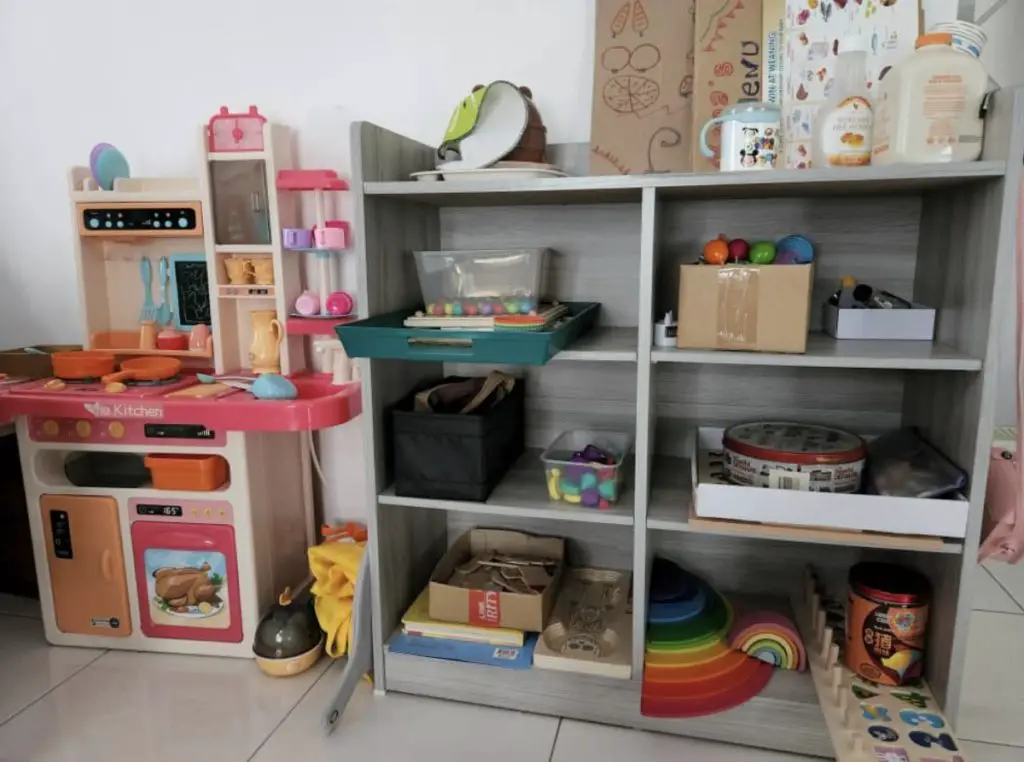
Arts & Creating Corner – An area for art supplies (paper, scissors, glue, color pencils, markers, etc..)
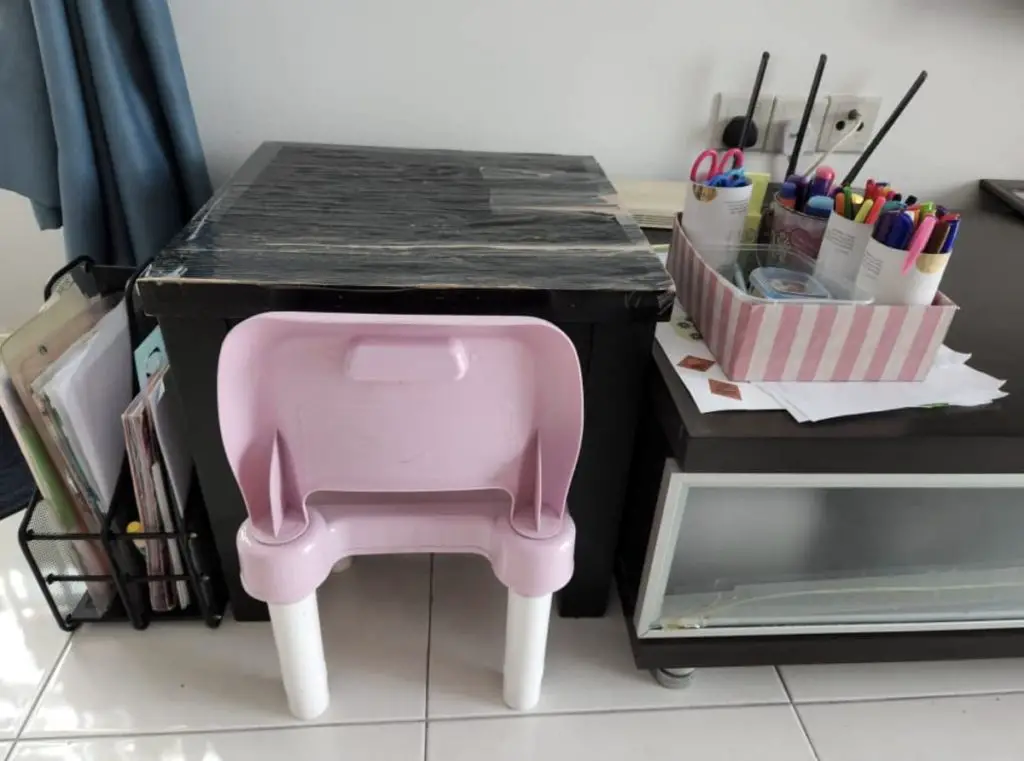
Dress Up & Pretend Play – An area for costumes (sunglasses, hair accessories, costume jewelry, firefighter’s costume, doctor’s costume, etc..)
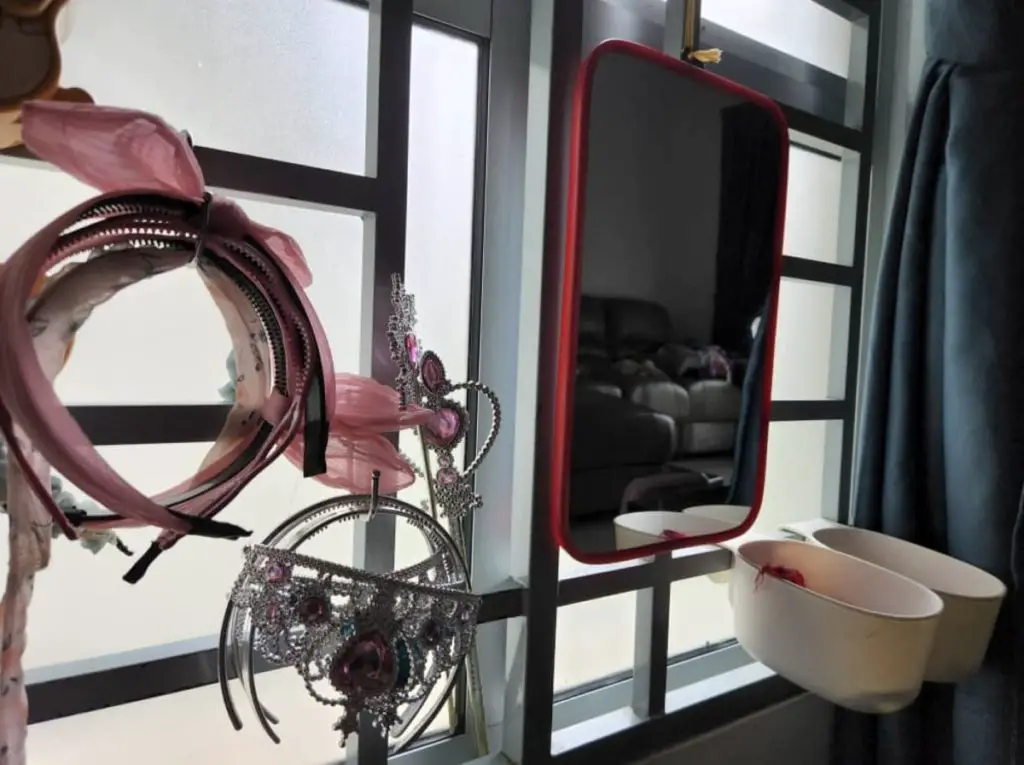
Books – An area for reading comfortably and with good lighting
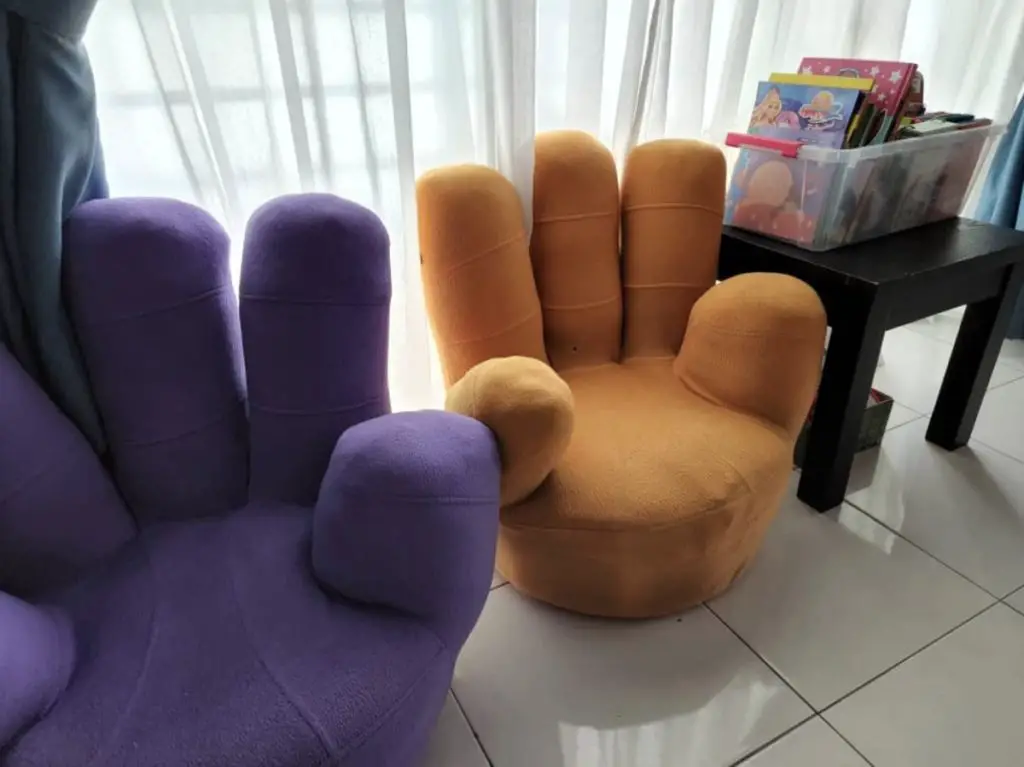
Learning Wall – An area where your child often sits where he can take a look whenever he is bored or just passing by. For me, this is my dining area. Whenever my daughters have breakfast, they will look at the wall and take in what is written on the paper.
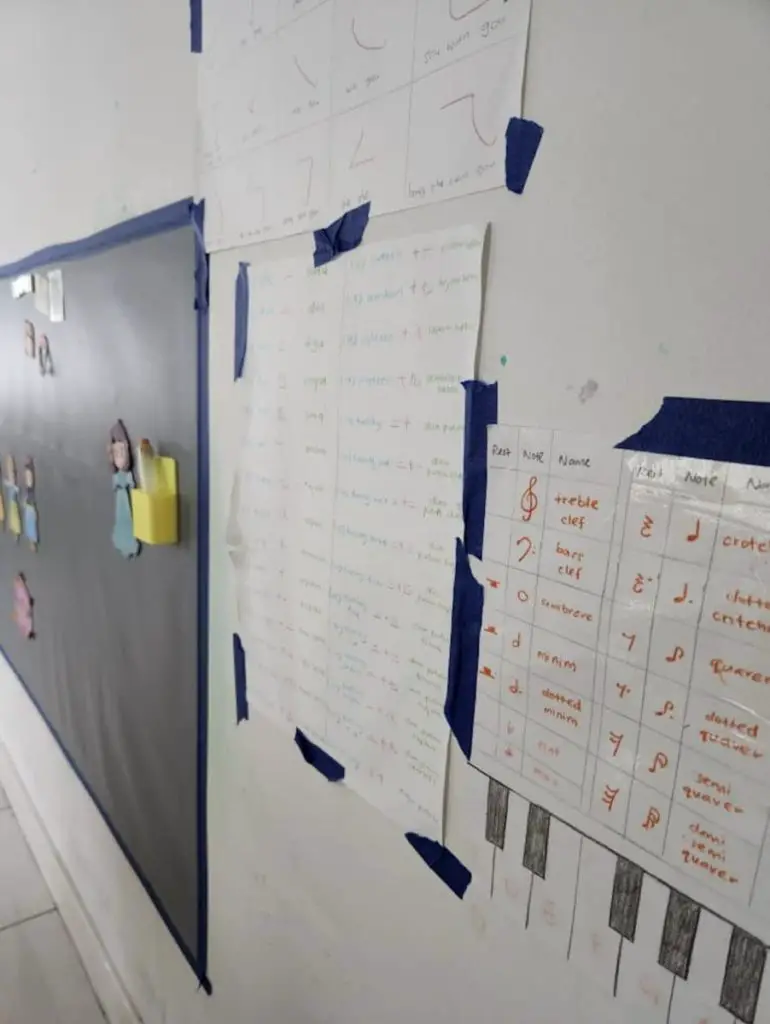
6. Maintain close proximity with your child
Sit nearby your child or at least be where he can see you while he plays. Children need that sense of security, knowing their parents are just around the corner. Now and then, he will turn to look for you or call for you. Assure him and acknowledge him with eye contact, a smile, or with your words such as: “Yes, mummy is here. Mummy is doing some work. You can continue playing.”
If the room is too silent, you may also turn on music or stories for your child to listen to while playing. He will have something else to focus on with the background music.
What everyone craves, whether young or old, is attention and affection from a loved one. Make sure you fill up your child’s affection-love-tank. The best is before you start your day, spend some quality time with him. Or you may set aside a designated time just to spend with your child. Once his affection-love-tank is filled, he is more able to be independent and more assured that you will not suddenly disappear or run away.
7. Teach your child about safety
During playtime, your child may suddenly decide to engage in arts and crafts. He may suddenly decide to create a card for someone, for example. Many times, this requires a pair of scissors and glue. That’s why you need to teach your child how to handle sharp objects safely and responsibly.
Pencils and rulers are considered sharp objects too. Once your child is taught how to handle sharp objects properly, he can handle them with ease and confidence, without the need to ask you to help him to take the scissors or cut for him. Do give him a constant reminder, and be consistent in applying the safety rules and also modeling it to your child.
Besides handling sharp objects, you should teach your child about other hazards and the cause-and-effect theory. Here are some examples that may be a hazard to your child:
- Papers left on the floor become a slippery surface to walk on.
- Loose parts or legos on the floor can cause injury to your feet.
- Scissors and pencils must be held in a certain way, never leave the table or be pointed at other people.
- When bending down to pick up something underneath the table or chair, always be careful before standing up.
- Never put anything around your neck.
- Keep the space clean by keeping the toys before moving on to another activity.
When your child understands safety and practices it, you will be more at ease to set up specific areas (arts & crafts) for your child to play with and play independently without worries.
Summary
In summary, after setting a realistic understanding of your child’s attention span according to age, you must also do some readjustments around the house and your schedule. Here’s a summary of all the points mentioned above.
| Understanding the type of toys | Be intentional about the toys that you buy and choose for your child. |
| Knowing your child’s interest and learning curve | Catch his interest and build on it. |
| Your role in modeling play | Your child models play not only with you but also with siblings or even on television. |
| Words of encouragement and lesser interruption | Instead of telling him how it should be done, encourage and prompt him with words. |
| A good play environment and accessibility to toys | Creates independence in your child as he can take what he can see and play with it better. |
| Maintaining your distance and reassuring your child | Being close to your child while not being too close all the time can help him find his independence while engaging in playtime. |
| Safety rules | Allow your child to understand and avoid danger during playtime. |
When your child starts to play independently, with a lesser interruption from you, you will be able to see his creativity flow and problem-solving skills increase. Do try it out, and I hope this will help you to catch a break or two in between your day. Happy parenting!

